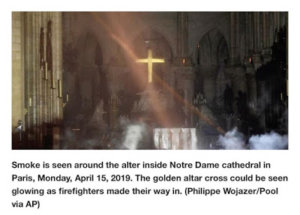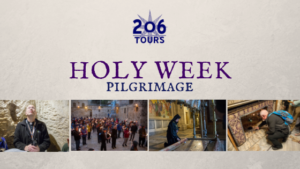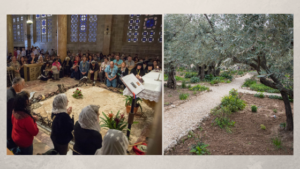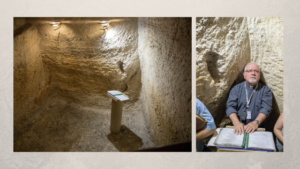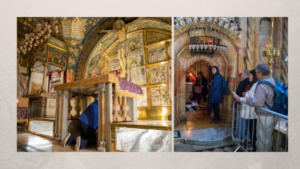Month: April 2019
Divine Mercy Sunday, or Feast of the Divine Mercy, falls on the Octave of Easter, and celebrates the encounter Saint Faustina had with Jesus known as the Divine Mercy. Jesus gave Saint Faustina the message of Divine Mercy on February 22, 1931 – in Lagiewniki (Poland).
St. Faustina joined the convent in 1925, taking the religious name, Sister Maria Faustina of the Blessed Sacrament. While assigned to a convent in Plock, Poland, St. Faustina developed an illness that required her to rest for several months at a nearby farm.
On the night of Sunday, February 22, 1931, Jesus appeared to her wearing a white garment with colorful rays emanating from His heart. She details in her diary that Jesus told her that the first Sunday after Easter is to be celebrated as the Feast of Mercy, and that He wished His image to be shown as He appeared before her – and for it to be venerated and displayed for all to see.
Jesus’ main message of the Divine Mercy devotion is to ask for, and receive, the Mercy of God through consistent confession, to trust in Jesus’ Mercy, and to show mercy to others as God would. Specifically, any person who receives Reconciliation and Holy Communion on Divine Mercy Sunday will receive a Plenary Indulgence.
Though St. Faustina could not paint, she promised to venerate this image. After a few years, with the help of Father Michał Sopoćko, she commissioned artist Eugene Kazimierowski to create the painting that has now become the famous image of Divine Mercy. It is accompanied by the phrase “Jezu ufam Tobie” or “Jesus, I trust in You.” The image has been replicated and distributed countless times, however, the original painting now resides at the Divine Mercy Sanctuary in Vilnius, Lithuania.
For years, St. Faustina conversed with Jesus and devoted her life to His mission of spreading Divine Mercy. Through her steady and impassioned work, the message of Divine Mercy did spread rather quickly through the distribution of brochures, books, and prayer cards. Divine Mercy became a source of inspiration and strength for the Polish people, as just before her death in 1938, St. Faustina predicted that a terrible war was approaching. By 1941, the image and message of Divine Mercy had reached many countries, even as far as the United States.
In the 1950s, both Pope Pius XI and Pope Pius XII personally spread messages of, and approved the devotion to, the Divine Mercy. St. John Paul II was an ardent supporter of St. Faustina and Divine Mercy – and so he Beatified her in 1993, and Canonized her on April 30th, 2000. Surprisingly, he closed the Canonization by officially designating that the Sunday after Easter as the “Feast of Divine Mercy”. Coincidentally, St. John Paul II died in Saturday, April 2nd, 2005 – on the eve of Divine Mercy Sunday. He was later Beatified by Pope Emeritus Benedict XVI on Divine Mercy Sunday in 2011, and Canonized on the Holy day in 2014 by Pope Francis.
The legacy and strength of the message of Divine Mercy has not wavered, much in part due to the loyalty and perseverance of St. Faustina and those who honored her legacy. St. Faustina now lies at the Divine Mercy Shrine in Lagiewniki, Poland. As her October 5th Feast Day approaches, we take this opportunity to reflect on her devotion and trust in the Mercy of Jesus.
To learn more about how you can visit:
www.206tours.com/stfaustina
Lithuania & Poland – 20th Anniversary of Divine Mercy Sunday
Tour: DM042025
Destinations: Poland
Duration: 11 days
Lithuania & Poland – Feast of St. Faustina
Tour: SF1005
Destinations: Poland
Duration: 11 days
Johnette Benkovic (Williams) is the Founder and President of Women of Grace, a Catholic apostolate for women. After experiencing a conversion in her faith in the early 1980s, Johnette set out to help other women to rediscover their Catholic faith by sharing the Gospel through various media outlets. Johnette has become a well-known and successful Author & Speaker.
This April, Johnette was called to join 206 Tours as a “Pilgrim”, and making a pilgrimage to Lourdes, Paris& Lisieux with her husband, Jack. Their Journey began on April 12th and they were in Lourdes when the tragic fire at Notre Dame Cathedral occurred. Just two days after the fire, the group made their way to Paris.
Below, is Johnette’s reflection on the eve of her arrival in Paris.
Jack and I landed in Paris in the early morning today from Lourdes and drove into the city with our tour through 206 Tours. We visited Sacre Coeur and it was a graced experience. This Friday, Good Friday, we were to have visited the Cathedral of Notre Dame.
I have never been to Notre Dame and like fellow Catholics from all over the world, I could not wait to experience her glory. Our visit will be tragically different now, like so many others who came here to see this magnificent witness to our Catholic Faith. But I know it will be no less poignant. To experience Notre Dame on Good Friday — battered and bruised as she is — will easily remind us of the ultimate sacrifice of Jesus Our Savior, and the salvation He offers to each of us if we choose to accept Him.
Just as the Crown of Thorns was spared from the inferno, so too does the passion, death, and Resurrection of Jesus Christ spare us from the furnace of flames known as Hell.
In the end, Notre Dame is just a structure, albeit a stunning structure and sign in our fractured and broken world. And most likely she will be rebuilt. But, she is limited and can only reside in one city and in one country.
However, Our Lord’s promise of eternal life, breathed from the altar of Notre Dame for hundreds of years, is omnipresent, and can live in each one of us. And though the sorrowful reality of this loss cuts deeply, the miracle of Easter is alive in this earthly devastation, reminding us that all is made new in the Resurrection of Our Lord Jesus Christ.
The Easter Sunday message, as well, as the message of Notre Dames’ horrible fire, is this: “Look forward and have hope!”
SOURCE: Johnette Benkovic Williams | Facebook, April 16, 2019
Our prayers are with Johnette and all the Pilgrims we have in France at the moment, as they experience this historic moment for Catholics all over the world. We thank Johnette for sharing her reflection with us, and thank God for sparing any loss of life – for saving all the relics, including the Crown of thorns – and most importantly, the Blessed Sacrament.
Holy Week is the most solemn, and meaningful, time of the year for Catholics. For centuries, Catholics have reenacted the events of Holy Week in homage to Jesus’s ultimate sacrifice for us.
A Pilgrimage to the Holy Land, visiting the sites of Holy Week, is an incredible way to connect deeply in prayer to Jesus. Below, you will see a brief breakdown of how modern-day Pilgrims (like early Christians before them) who are “literally” following in Jesus’s footsteps, remembering Holy Week, and Christ’s Passion in the very places where it took place:
Palm Sunday
On Palm Sunday, Jesus made His triumphant entrance into Jerusalem while riding a donkey. He was welcomed by crowds who worshiped Him and laid down palms before Him, before making His way to Bethany where He raised Lazarus from the dead.
Tour 111 visits Jerusalem and Bethany on Day 7.
Tuesday
On Tuesday, from the Mt. of Olives, Jesus looked out over Jerusalem and spoke to his Disciples of the imminent destruction that would befall the city. Dominus Flevit is a Church that now sits on the Mt. of Olives, commemorating the spot where Jesus wept for the city of Jerusalem. On Tuesday night, Judas conspires to betray Jesus.
Tour 111 visits Mt. of Olives and Dominus Flevit on Day 8.
Holy Thursday
On Holy Thursday, Jesus and his Disciples celebrate the Last Supper in the Upper Room on Mt. Zion. At night, Jesus goes to the Garden of Gethsemane and prays in agony, alone, before his arrest. The Garden sits at the foot of the Mount of Olives, and still contains trees whose roots date back to the time of Jesus. Now, the Church of All Nations stands over the Rock of Agony.
He was then taken to the house of the High Priest, Caiaphas, where He was examined and eventually imprisoned. This is now the site of the Church of St. Peter in Gallicantu as it commemorates Peter’s denial of Christ (three times) and Jesus’ forgiveness.
Tour 111 visits the Upper Room on Mt. Zion, the Garden of Gethsemane, the Church of All Nations (Rock of Agony), and the Church of St. Peter in Gallicantu (House of Caiaphas) on Day 8.
Good Friday
On Good Friday, Jesus was condemned to death by Pontius Pilate at the Antonia Fortress. Pilgrims who visit the Holy Land walk the true Via Dolorosa, or, The Way of The Cross. The starting point is the same as where Jesus’s Road to Calvary began. The Stations of the Cross has you traveling through the markets of the Old City. The Church of the Holy Sepulchre marks the sacred destination that is Calvary, Jesus’s Crucifixion site, and His Tomb.
Tour 111 walks the Via Dolorosa on Day 9 ending in Mass at the Church of the Holy Sepulchre.
Easter Sunday
On Easter Sunday, Jesus rose from the dead in the miracle of His Resurrection, and visited two of his Disciples at what Luke describes as Emmaus. What is now the Church of the Resurrection, in Abou Gosh , it is believed to be the site of Jesus’s Resurrection.
Tour 211 visits Emmaus on Day 10.
The Holy Land is a deeply sacred place for all Catholics. Visits to the sites where Jesus lived and died bring the scriptures to life, like nothing else. Join us on one of our many departures to the Holy Land on Tour 111, Where Jesus Walked or Tour 211, Return to the Holy Land.
[DISPLAY_ULTIMATE_SOCIAL_ICONS]

